Ramp salt is a foragers classic anyone can make at home. It's one of the easiest wild food recipes to make, especially for beginning foragers. You'll need a food processor, a dehydrator, and something to spread a paste of ramp leaves on like a silicone baking sheet. Read on and I'll explain the basic process and what you can do with it.
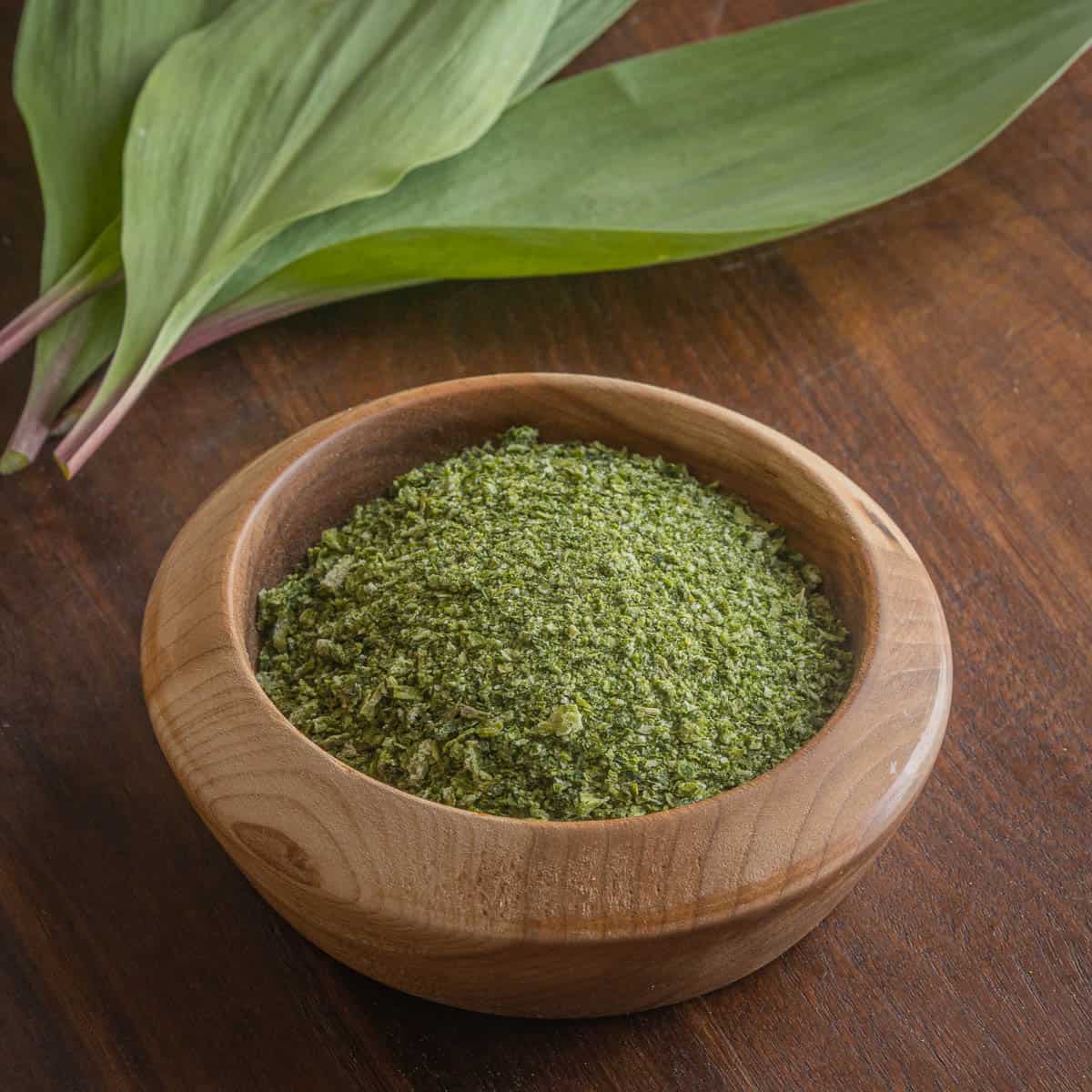
What is Ramp Salt?
Ramp salt is a flavored salt infused with taste and aroma of fresh ramp leaves. It's easy to make at home with a dehydrator or in the oven and can be used as a finishing sprinkle on different dishes. It's a good entry-level way to preserve ramps.
You can use many different allium greens here. Allium tricoccum is pictured, but Allium burdickii and many others can be used. If you're in Europe, you can make ramson salt with Allium ursinum (bear garlic).
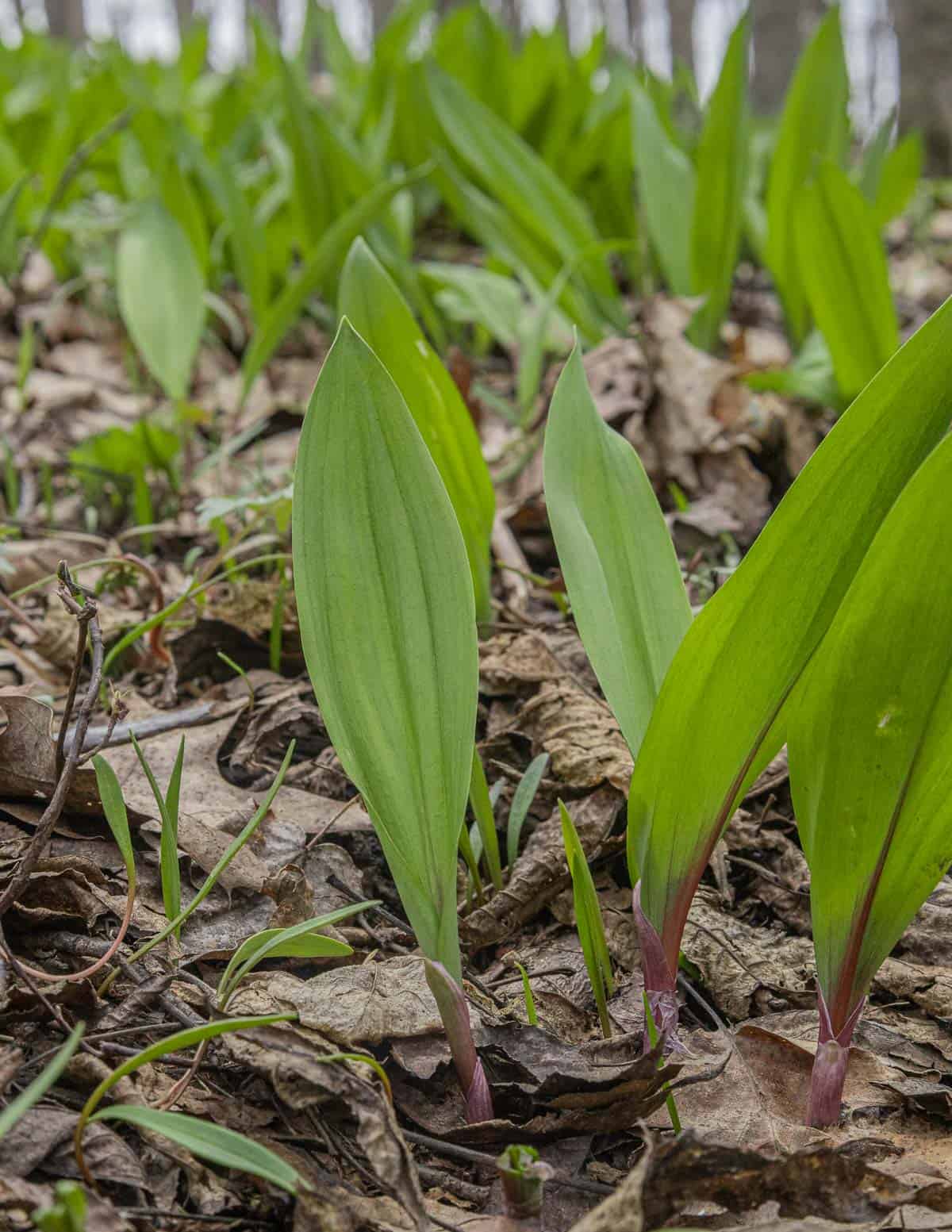
How to Make Ramp Salt
To make ramp salt, you harvest fresh wild leek leaves, wash and dry them, and weigh them on a scale. After weighing, you slice the leaves and process them to a paste with a specific amount of salt.
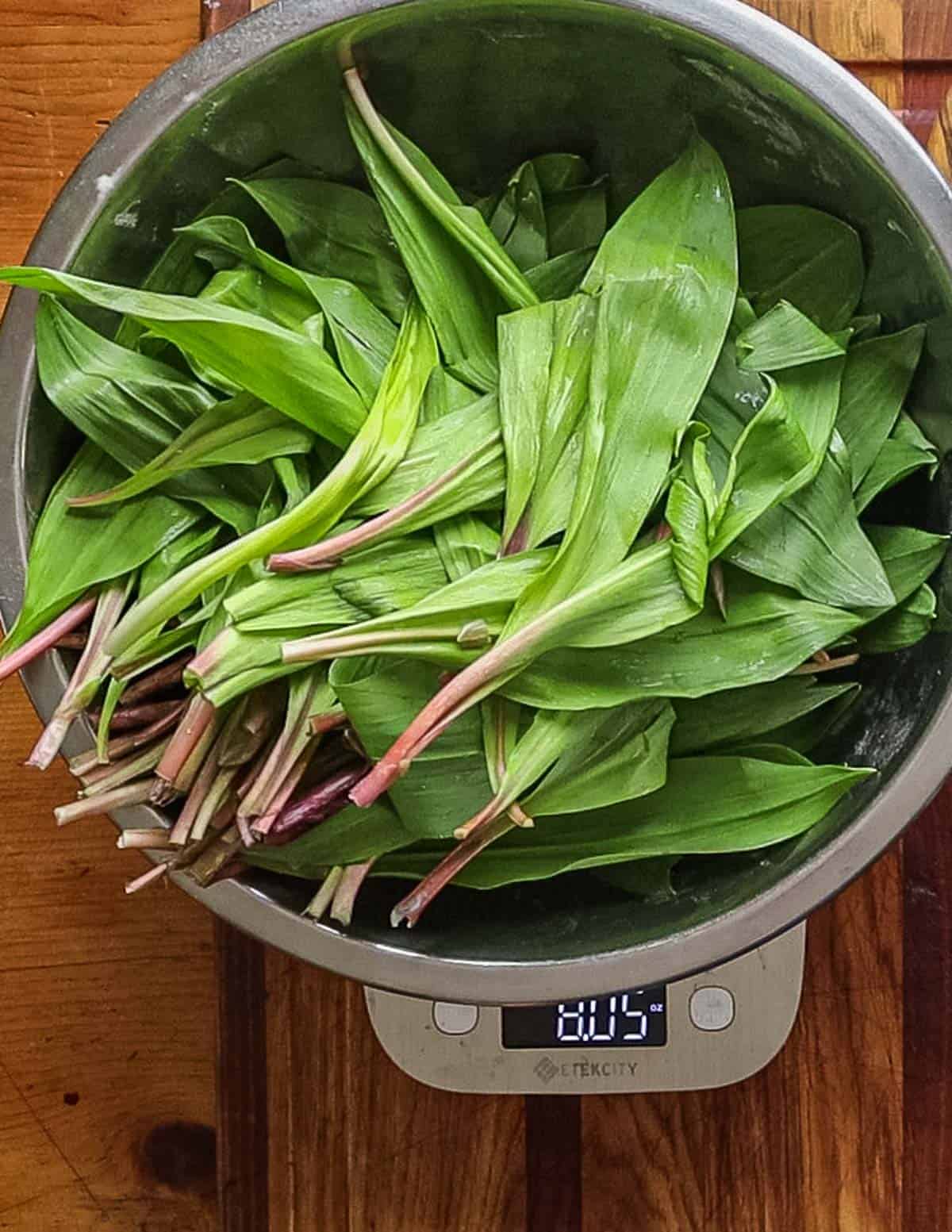
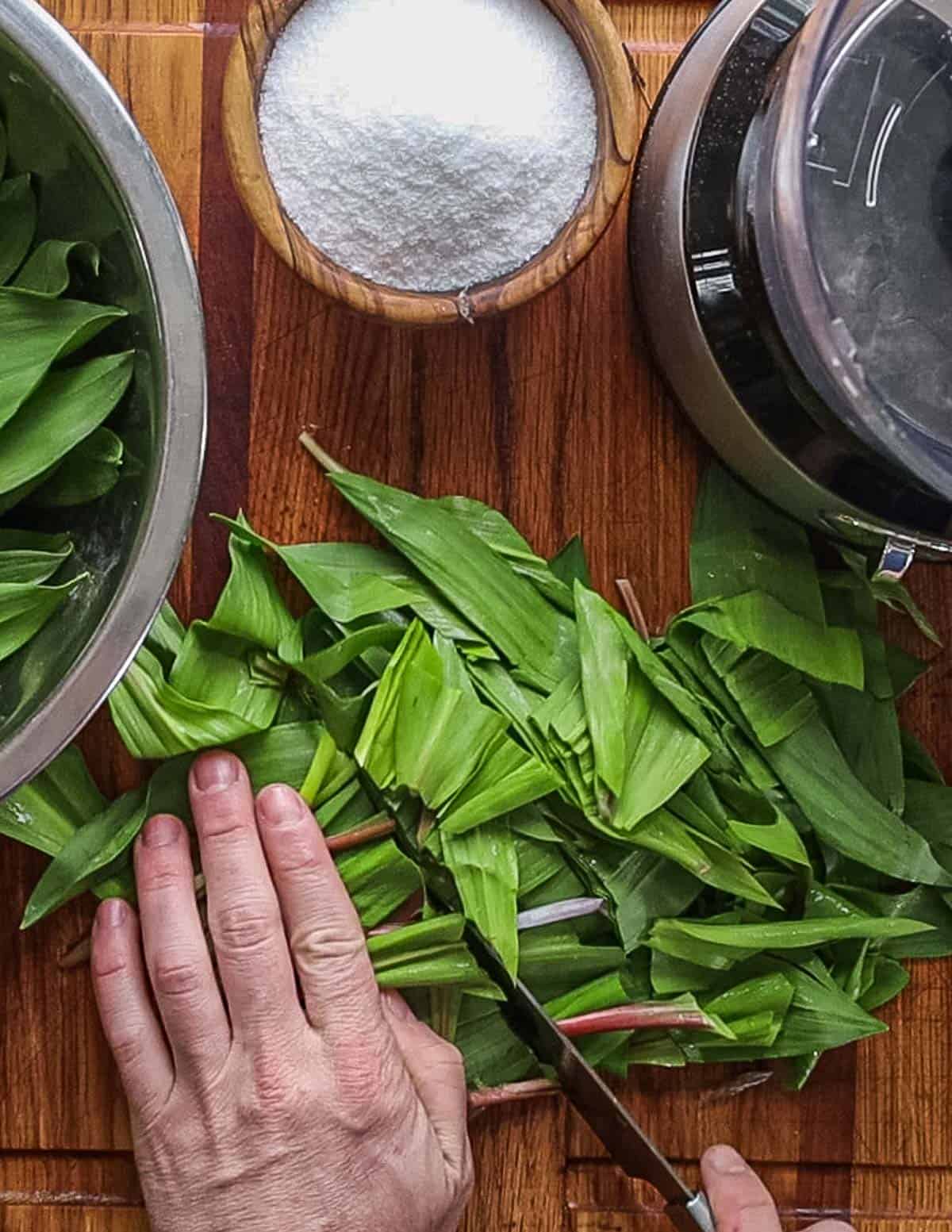
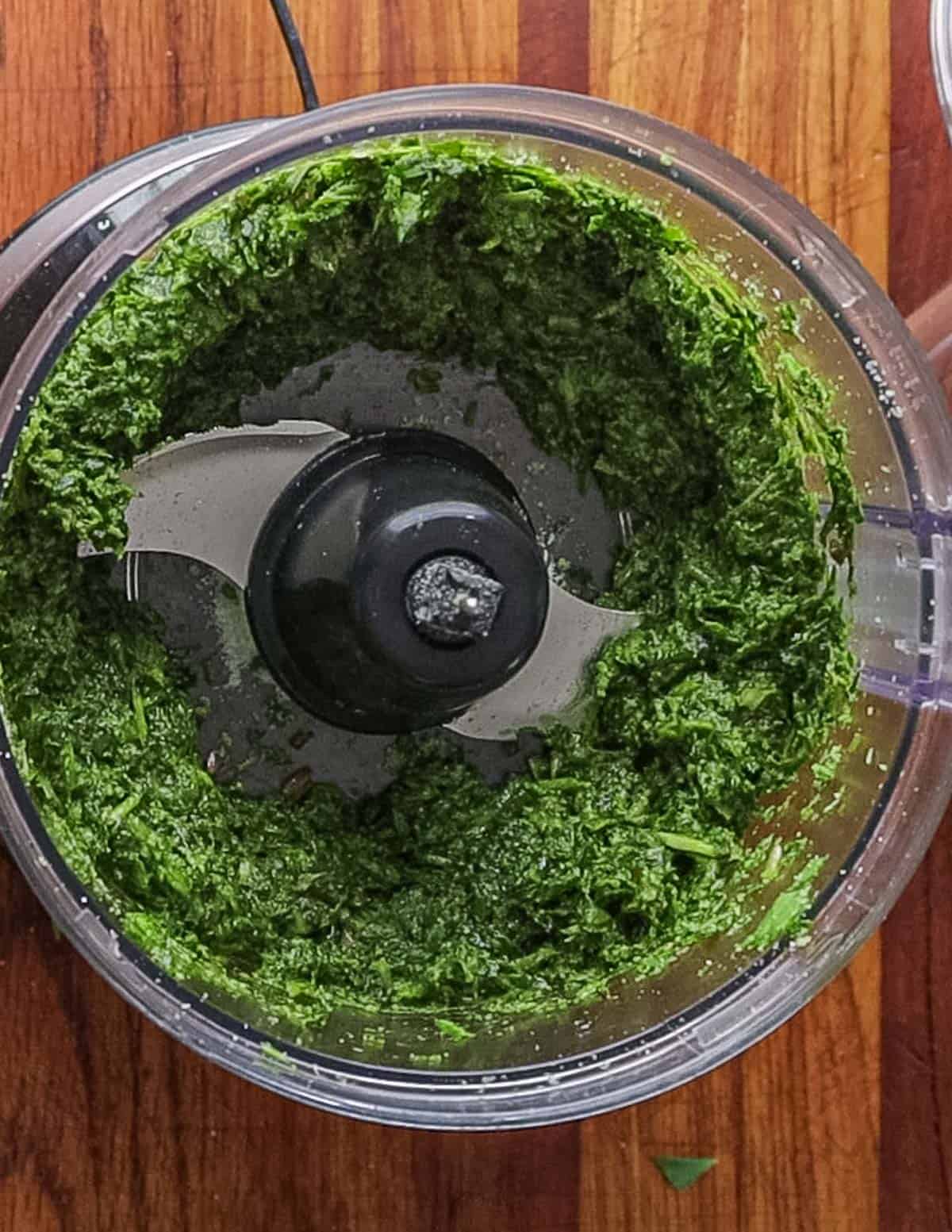
The paste is spread on a silicone sheet or parchment paper and dehydrated. The juices of the ramps infuse into the salt as it dries. Halfway through the drying process, the sheet of dried ramp salt is flipped to encourage even dehydration.
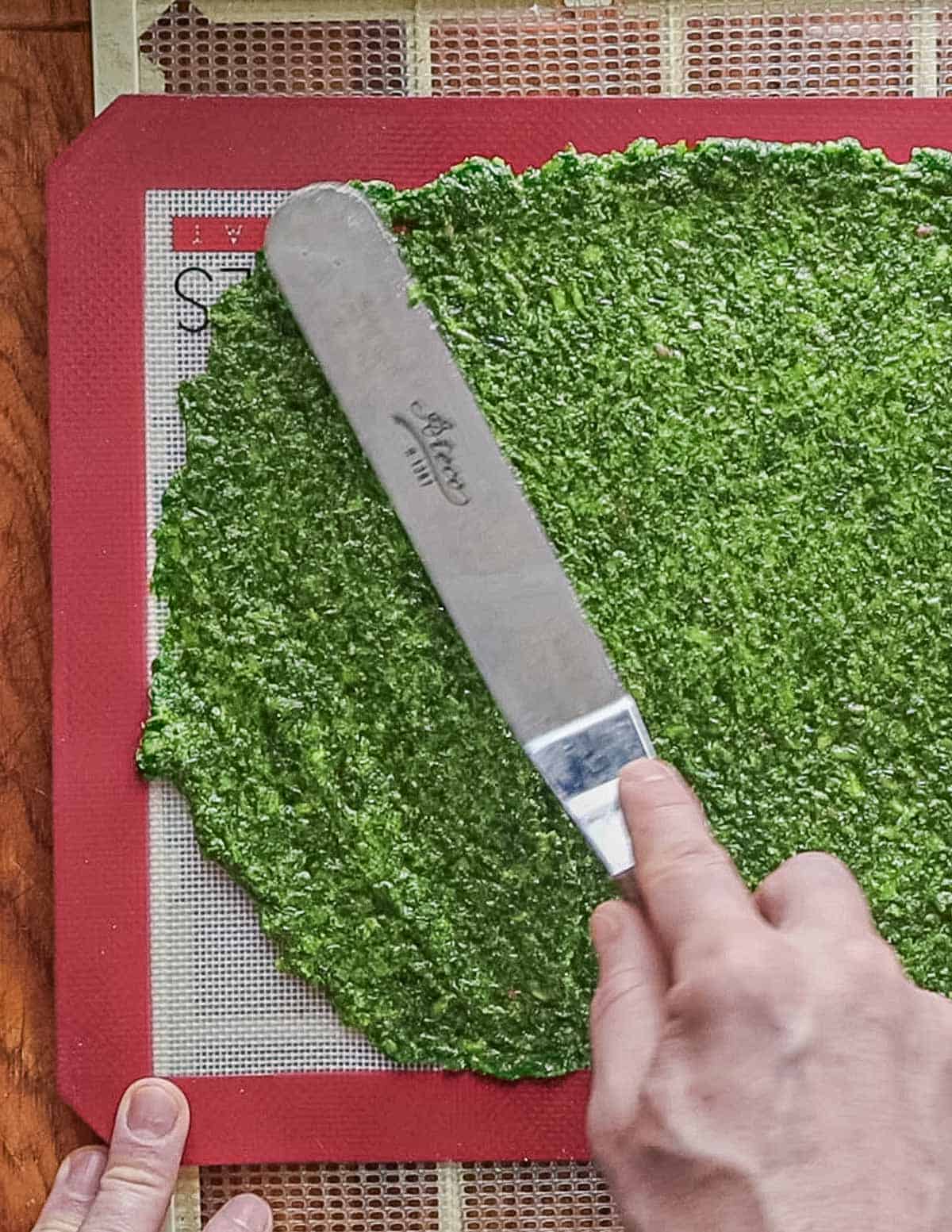
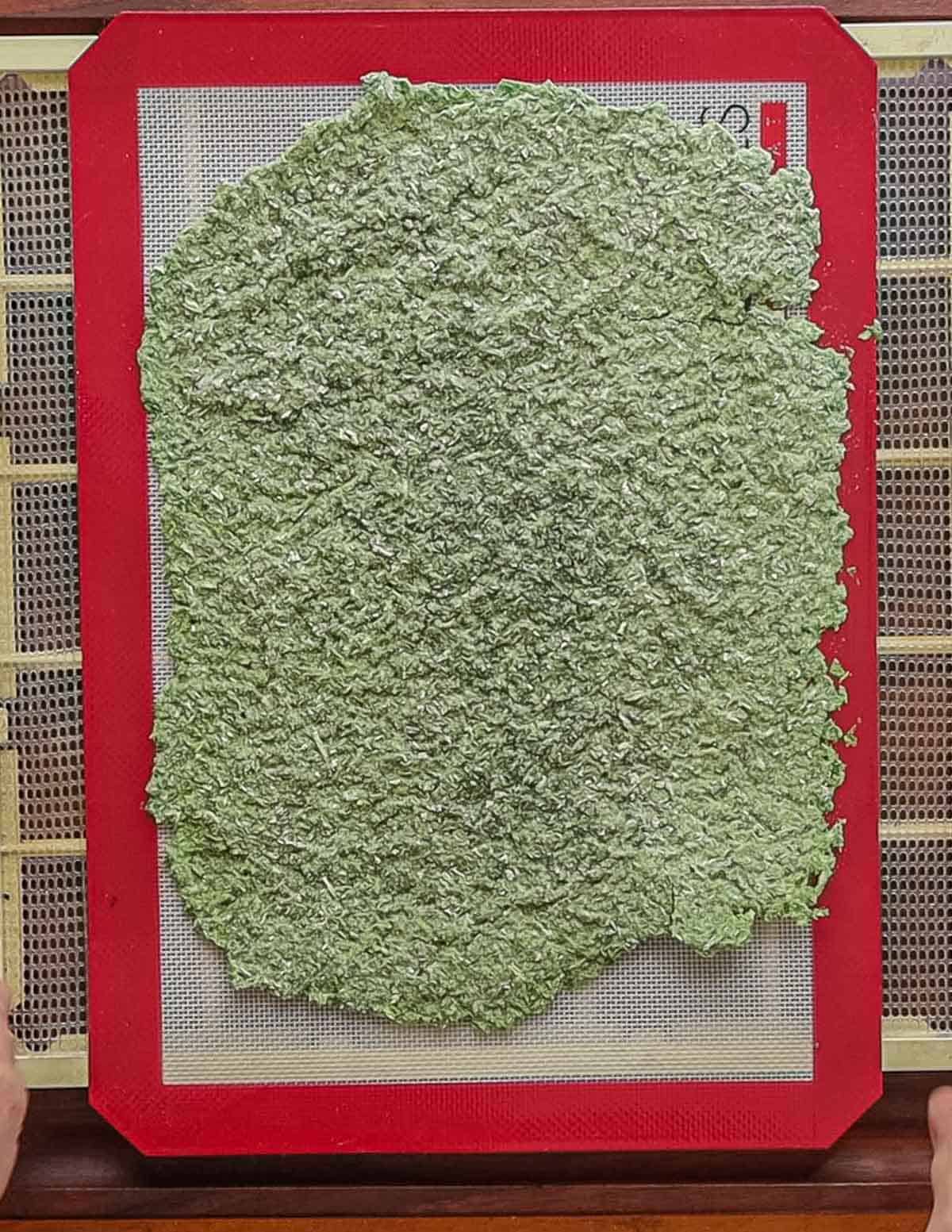
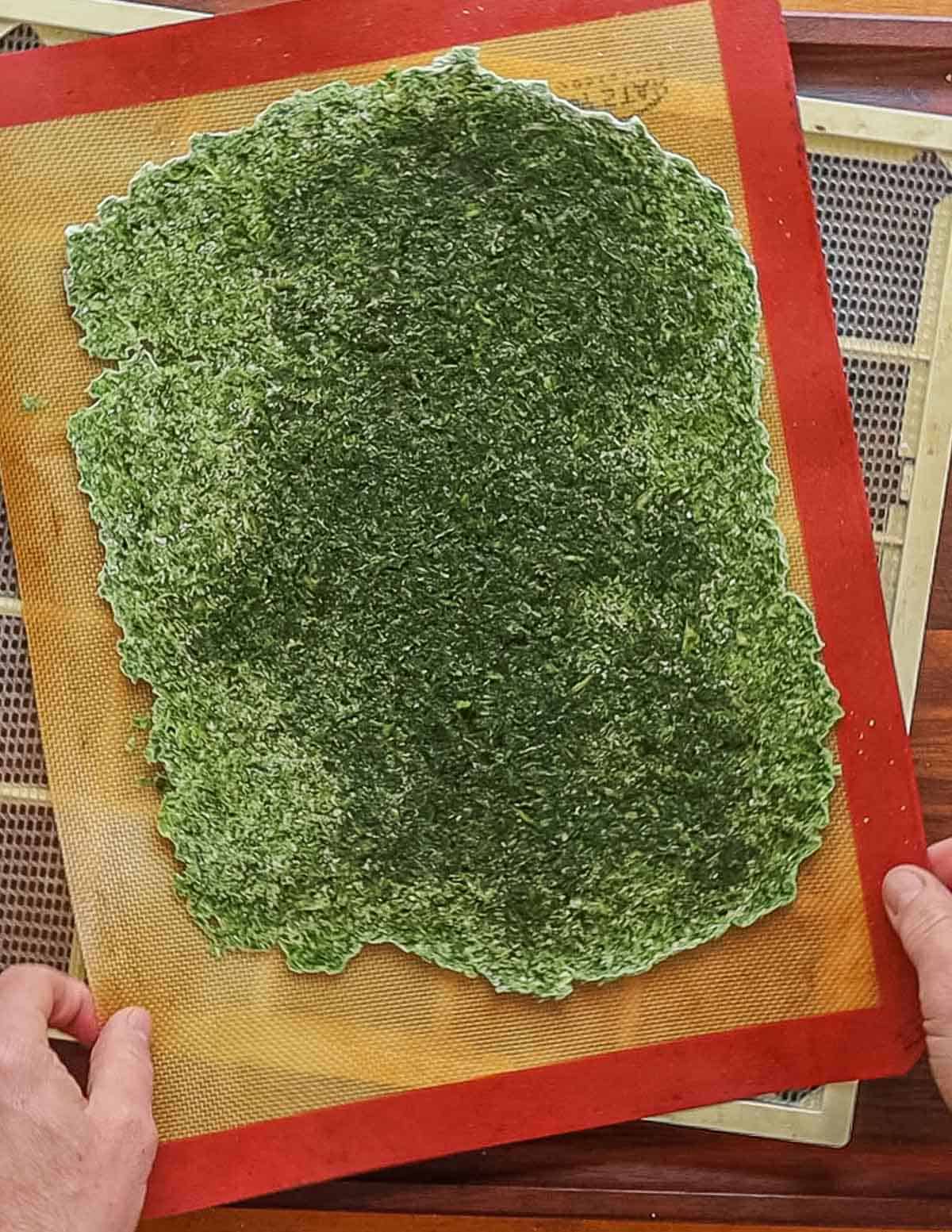
After the ramp salt is bone-dry and brittle, it's gently crushed in a mortar and pestle and stored in a jar until it's ready to use.

How to Use Ramp Salt
Think of ramp salt as a finishing salt you can add to different dishes at the last minute. I like a sprinkle on eggs and roasted potatoes, as well as using it to finish fish and steaks like you would other finishing salts. It's also great used to finish homemade hash browns.
Chef's Tips
- Some ramp salt recipes tell you to just mix dried ramps with salt-this doesn't work and will not give you anything special.
- It's important to use the low setting (100F) in order to keep the light green color and flavor of the ramps. Since the salt is dehydrated for multiple days, using a higher heat setting can change the flavor.
- For a deeper depth of flavor, you can ferment ramp leaves, add extra salt and then puree and dehydrate. I explain how to do this in the recipe notes.
- You might be tempted to grind the salt in a spice grinder-don't do that. You want some texture here, and you'll get more flavor from it if the salt is slightly coarse.
- If you don't want to make your own, many places have ramp salt for sale online and it can also be found at farmers markets sometimes. But, you should know most of the salts I've tried aren't very good.
Ramp Salt
Equipment
- 1 mortar and pestle
- 1 Dehydrator
Ingredients
- 8 oz fresh ramp leaves
- 3 oz kosher salt
Instructions
- Wash and dry the ramp leaves, then weigh out 8 oz of them (roughly 8 cups sliced leaves).
- Working in batches if needed, put the leaves in a food processor with the salt and process to a rough, spreadable paste.
- Spread the ramp paste onto a silicone baking mat on a dehydrator tray, or use a sheet of parchment.
- Dehydrate the ramp salt at 100 F (low setting) in a dehydrator, flipping the sheet of salt over to encourage even dehydration after 24-36 hours. Continue dehydrating until the salt is cracker dry, about 24 hours more.
- Break the green salt into pieces and crush in a mortar and pestle to break it up. It should be slightly coarse. Since the salt content is lower than finishing salt, you can use more of it on finished dishes.
- Store the finished salt in a jar in the refrigerator for the best flavor. Room temp is ok, but the flavor will soften with time.

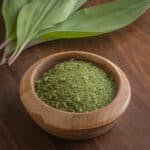
Kris
This is my second year making this recipe and I'm now remembering my confusion last year... is it 3oz of salt by weight or volume? Thank you!
Alan Bergo
Always by weight. Some salts vary drastically by volume, for example, 1/2 cup Diamond kosher salt weighs half as much as 1/2 cup Morton kosher.
Steven
Hi Alan, thanks for the great recipe. I am wondering what herbs or other ingredients work well with the same process, as I'd like to have a variety of finishing salts. I made a batch of sage salt using these steps and it's decent, but the difference in moisture content seemed to lead to less of a smoothly infused paste, and it didn't preserve the flavor nearly as strongly compared to ramps.
Alan Bergo
Hi Steven, I'm pretty picky about salts and I really only make two right now. Besides the ramp salt you have to try hot pepper salt.
Lori
I came across a Tuscan Herb recipe from The Elliott Homestead that is delicious. Enhances roasted spatchcock chicken to another level!
Ingredients:
2 c good quality salt
1 c sage leaves
1/2 c rosemary leaves
1/2 c thyme
Zest of 2 lemons
2 cloves garlic
1red chili or 1/2 tsp chili flakes
All herbs used are fresh only.
Basically follow directions as above for the ramp salt.
Enjoy!
Alan Bergo
Lori this is so great, thanks for sharing. I'm so making a lovage/garden herb version this year.
Kristin
Well, I'm definitely guilty of just mixing dried ramps with salt and then wondering why it really just tasted dusty. Tried this version at a tasting you did this last fall and can't wait to make it this spring!
Alan Bergo
It’s a simple change in technique to puree the ramps with salt but once you try it you won’t go back!
Isaac Willis
I made this with almost 2 lbs of ramp leaves this spring. I and all of my friends & neighbors are totally addicted to it!
They haven't even had my latest incarnation which was to put it in a coffee grinder with some dehydrated chanterelles. Now I have ramp mushroom salt, super fine and just the thing for well, just about everything!
I love yer site. I'm up to a good 40-50 different species of wild plants and mushroooms and eat them every day; frozen, preserved, pickled and fresh. So much healthier because of your knowledge and willingness to share. Thank you!
Alan Bergo
Hey thanks Isaac. I made a big 10 lb batch to give away at events this year. Everyone loves it.
Andrea
Hi!
Would this recipe work to use frozen ramp leaves in place of fresh picked?
Thanks so much!
Alan Bergo
If they were blanched beforehand, definitely not. Freezing ramp leaves raw also makes them very tough, so I'd just use fresh leaves.
Cherry
Hi! For the fermented ramp leaves, is it really only 6 grams of salt : 8 oz of leaves? That feels like such a little amount of salt. Why is that?
Alan Bergo
That’s because most ramp salts don’t actually taste much like ramps. With this recipe, there’s a higher proportion of ramp leaves so that you get actual, physical pieces of ramp mixed in with the salt. Using less salt in the recipe allows you to use more ramp salt to finish whatever you’re serving, which means a stronger ramp flavor, which is what we’re all after.
Nan
The recipe instructs to add 50 more grams after 2 weeks of fermentation.
Upstate of Mind
It’s ramp season in upstate NY! Is there another ratio if I use sea salt instead? Or is kosher salt crucial?
Alan Bergo
No you can just use your favorite salt.
Bre
It's my first time being gifted ramps, as I haven't found any in my area yet. I also don't have a dehydrator, so will the lowest setting on my oven work if I spread the paste onto parchment? Thanks!
Alan Bergo
Yes it will work, but it will take much longer than a dehydrator. You’ll need to keep the oven door propped open and monitor the heat. If it cooks then it’ll still work but the flavor won’t be as strong. You want the heat low-ish. 150F max, and even that’s a little high for me, personally.
Also, please don’t leave a star rating when you haven’t made a recipe. Leaving 4 stars on your comment means you’re rating my work as lacking in some way (>5stars) Google sees that and penalizes me. I live in the Matrix, unfortunately.
Robert
It smells absolutely terrible. I have been doing this in an oven and keeping the temps between 100 and 110 by just barely allowing a preheat function. Coming up on 24 hours and it’s not good. The ramps were freshly foraged too. What’s happening?
Alan Bergo
A big part of the reason you use the dehydrator is it will save you and your family from the smell of ramps needing to dry for over 24 hours directly inside your house. Dry it in a dehydrator in the garage and you won’t have that issue. Drying ramps is also nothing compared to fermented ramps-you should try those next 😄. You can put the tray outside and try it in the sun with a fan too.
Chelsea Risser
Thanks for this recipe! Just wondering if you have a favorite kosher salt to use for this? I have diamond crystal on hand but would it be even better if I use a coarse finishing salt? I know diamond crystal is less salty than some salts.
Alan Bergo
Diamond or Morton kosher.
Suzanne
I'm making a note on the calendar for next ramp season so I remember to make salt with fresh ramp greens. Full disclosure, I have a quart of ramp greens we use as seasoning, but am going to mix some up with some sea salt to use it up (I'm sure you're cringing..sorry!). We'll be so delighted to make some real ramp salt next spring, but sadly, will have to use our peasant salt until then 🙂
Alan Bergo
Hey hey it's ok. I'll be here if you have any questions come spring.
George
Many thanks for this recipe, I just put a batch in the dehydrator and look forward to seeing how it turns out. This has been an excellent ramp year here in northern MN. Last year I made ramp powder by just dehydrating the leaves, this will be better.
Alan Bergo
Thanks George. It will be better. It's crazy how strong it tastes compared to some of the stuff people try to sell.
Jackie
About how much does one batch make 1 or 2 - 4 oz jars??
Alan Bergo
Hey Jackie, the recipe makes about a cup, which would be 2 4 oz jars.
Michele
Thanks very much for this recipe! I am wondering if you think this would be another successful way to use garlic mustard as well?
Thanks!
Alan Bergo
Hi Michele, no, garlic mustard shouldn't be used here. If you want to preserve that, I would dry it, or blanch and freeze.
Al Chomica
Such a timely recipe. And it is very appropriate to see that this salt is made the right way where the flavour is infused into the salt grains at a cellular level. Good to know about the temp changing the colours of the ramps too because that was an issue I was trying to solve so thank you for that tip. So many of the salts we see for sale are just dried herb(s) and salt mixed together which isn't a very good product. When the juices from the herb are drawn into the salt by osmosis then the flavour has gone into the salt. We just added to our ramp and Bauerlach crops this year and make this very salt from fresh leaves. At this time of year we also make a similar, but far different aroma, salt this way from fresh spruce tree tips. And the very best salt we can make is done this same way but we use unripe, green Sichuan Peppercorns. All of the sea salt we use for our gourmet salt lineup is a coarse grind. We smoke it to a rich brown colour in our smoker where we do ribs, oysters and other foods over the course of a year. This smoking adds a very nice flavour and brings it to a new level. Keep up the great posts. I can show them to my wife so she sees that great chefs are doing what I try to emulate and doesn't think I am so weird...
Alan Bergo
Hey Al, glad you could get something from this. It's such a simple thing, but seeing all kinds of salts for salt that are just dried salt mixed with herbs was driving me crazy. I'm going to have to make one with green Szechuan peppercorns now!
Chantel
I’m making ramp salt for the first time and have been trying to figure out which recipe to follow. Your comment just sold me on using this one because a flavor infusion is exactly what I wanted.
Alan Bergo
Thanks Chantel.
JMC
Hi. Are you able to do this without a dehydrator? Could I bake in the oven and dry in the sun? If so, details on time would be great!
Alan Bergo
You can do it without a dehydrator. There's a few options. You can leave the paste of ramps and salt spread on a baking sheet lined with parchment until it's dry in a warm oven with the lid ajar, you'd want to have the temperature about 175 F and it could take over 24 hours. Doing it in the sun is probably better, and you could spread the ramp and salt paste on a tray, put it in a sunny place and blow a fan on it for a few days. It's best to dry things like that on a porch as it will make your house smell something fierce, which is why the oven is not going to be the best option for most people.
Linda Reinhar
So many of your recipes use ramps. I live in Alaska. Can you suggest a northern substitute for ramps? Would chives work?
Alan Bergo
There’s lots of ramp recipes right now because it’s their season and I always cook with them in the spring. You can use green garlic instead-chives are better made into oil.